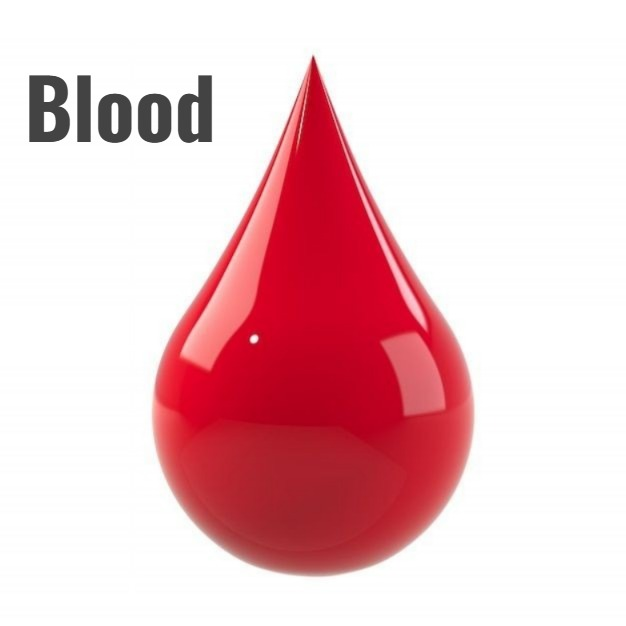—ENGLISH-ANATOMY UNIT 3. THE BLOOD
BLOOD:

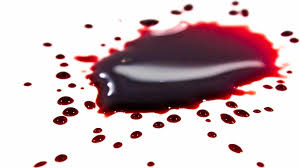
- Blood is a very important component in our body. A person’s life is not possible without blood. This is a type of connective tissue.
- Blood circulates in our body in blood vessels. The circulation of this blood starts in the body due to the continuous pumping of the heart.
- Blood is a liquid whose quantity in our body is 7 to 9% of our weight. That is, in a healthy adult person, it is found as much as 4 to 6 liters.
- Blood is a red colored liquid. The color of oxygen-rich blood is bright red due to the mixing of oxygen in the blood. When there is an absence of oxygen in the blood, i.e. the presence of carbon dioxide, the color of the blood appears dull red or less red.
- Blood is thicker than a liquid, which is called its viscosity. It ranges from 3.5 to 5.5.
- The specific gravity of blood is 1.045 to 1.065.
- Blood has slightly alkaline characteristics. Its pH is 7.35 to 7.45. Blood in arteries is more alkaline than blood in veins because it does not contain carbon dioxide molecules.
Composition of blood:

- Blood is a type of connective tissue. Its composition consists of 55% plasma and 45% blood cells.
- When blood is taken out of the body, collected in a tube and kept for some time, a light yellow liquid part appears on top, which is called plasma. Below it, a dark red liquid is seen collected, which is called a cell. The components of this plasma and the cell are as follows.
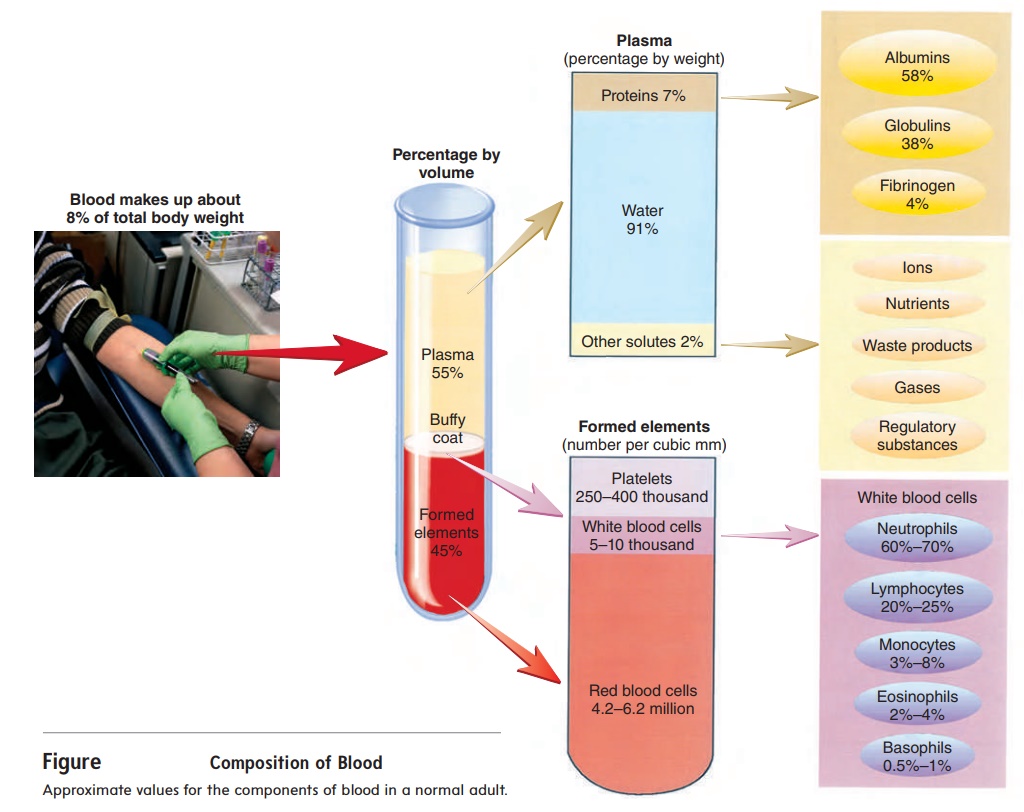
Components present in plasma:
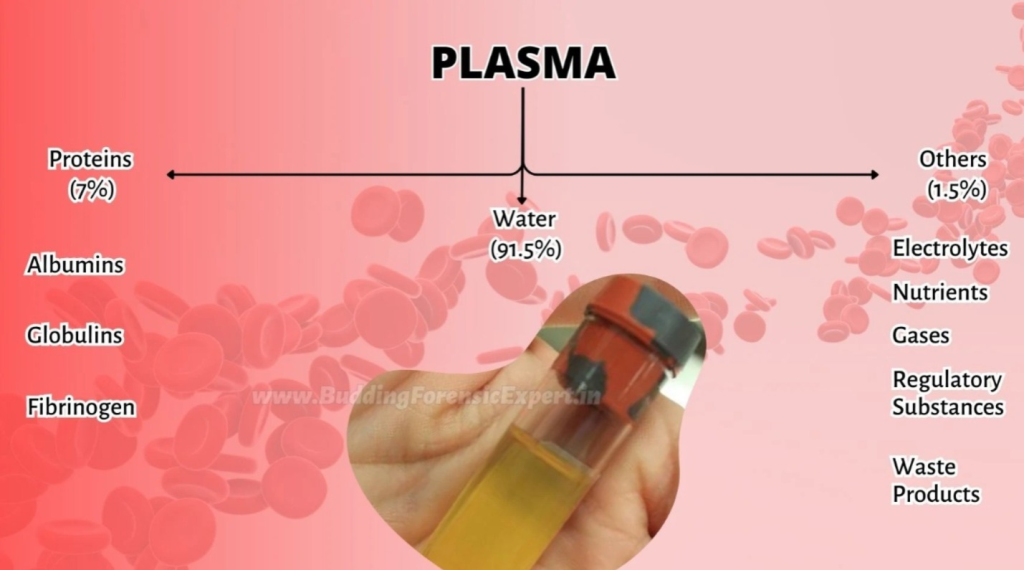
1. Water:
- Plasma contains the highest amount of water, about 92% water.
- Water is very important to maintain normal hydration in the body. Water plays a very important role in maintaining intracellular and extracellular balance in the body. The water in plasma is easily available to every cell and tissue through the blood and every cell and tissue can function well.
2. Protein:
- Plasma contains proteins called albumin, globulin and fibrinogen. Which is found in about 7% of the total plasma.
Albumin (Albumin):
- Albumin is the most abundant protein in plasma. It is produced in the liver and performs the following functions. It functions to maintain the osmotic pressure of plasma. Albumin also acts as a carrier molecule for some other substances, that is, it helps in transporting them.
Globulin:
- Globulin is a protein found in blood plasma. It is produced by the liver and is of three types. In which alpha, beta and gamma are the types of globulin proteins found in the blood. Gamma globulin works to maintain immunity in the body.
Fibrinogen:
- It is a protein present in plasma. It is produced by the liver and plays a very important role in the blood clotting mechanism.
3.Plasma Electrolytes:
- Plasma contains certain electrolytes. Electrolytes with a positive charge are known as cations. E.g. Sodium, potassium.
- Electrolytes that have a negative charge are known as anions. E.g. chloride, sulfate, iodine etc.
- These electrolytes act as minerals and are important for maintaining the osmotic pressure of the cell.
4. Nutrients:
- At the end of the digestion process in the body, the absorbed nutrient materials enter the blood and mix with the blood plasma. These nutrient materials contain macro and other micro nutrients like carbohydrates, proteins, fats etc. which are supplied to every cell of the body through blood plasma and the cell can perform its functions.
5. Gases:
- Some gases combine with blood plasma and circulate within the body through blood plasma. In which oxygen, carbon dioxide and nitrogen are mainly present.
6. Waste Products:
Any waste product produced by the cells at the end of digestion in the body. That waste product combines with the blood plasma and reaches the body’s excretory organs before exiting the body. These waste products include urea, uric acid, creatinine, bilirubin, etc.
Blood cells:
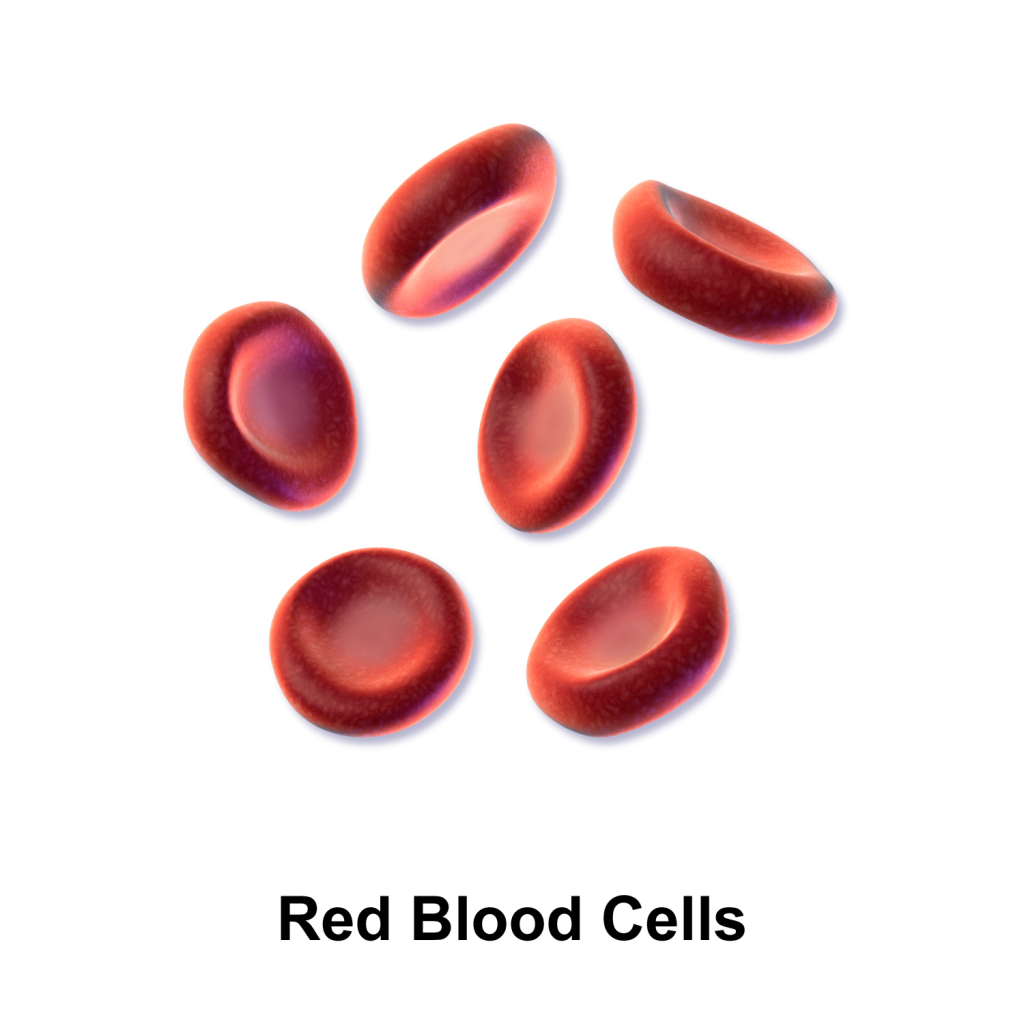
Red blood cells or erythrocytes (Red blood cells or erythrocytes.)
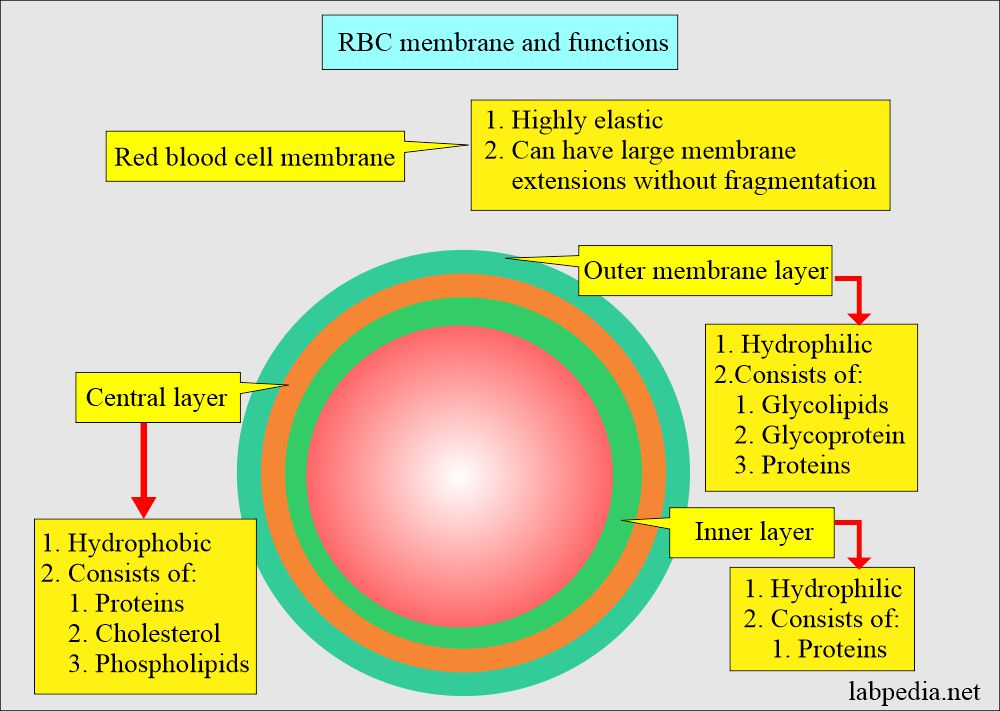
- RBCs constitute 99% of all cells in the blood, i.e. the largest part.
- RBCs are biconcave cells without a nucleus, like circular discs.
- Its diameter is approximately 7 microns and its thickness is 2 microns.
- Immature RBCs have a nucleus while mature RBCs do not.
- This RBC contains a protein called hemoglobin. Due to which its bright red color is seen. Hemoglobin and oxygen combine with RBC to form a compound called oxyhemoglobin and due to this it appears bright red in color.
- This oxygen enters the lungs through the lungs and combines with the RBC in the blood and reaches every cell and tissue of the body. Therefore, the main function of RBC is to deliver oxygen to the cell-tissue.
- The life span of RBC is 90 to 120 days.
- There are four to five million RBCs in the blood.
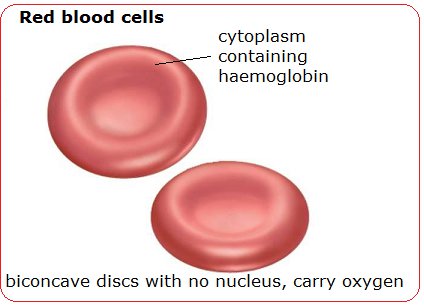
RBC production:

- The process of RBC formation is known as erythropoiesis. This process takes seven days to complete and a hormone secreted by the kidneys, erythropoietin, plays a very important role in this process.
- Before the birth of the baby, RBCs are formed in the liver and spleen of the baby during pregnancy. But after birth, they are formed in the bone marrow cavity of the long bones. RBC production occurs especially in the red bone marrow of vertebrae, ribs, sternum bone, pelvic bone, humerus and femur bone.
- Some nutrients like amino acids, riboflavin, folic acid, vitamin B etc. are very important for the production and maturation of RBC. Due to the presence of these elements, RBC matures are prepared.
- The main factor responsible for the production of RBC is the hormone erythropoietin secreted by the kidneys. The secretion of this erythropoietin hormone depends on the oxygen saturation of the blood in the arteries. When oxygen saturation decreases, this hormone is activated and this hormone stimulates the production of more RBCs. This mechanism is called a negative feedback mechanism.
Destruction and Removal of RBC:
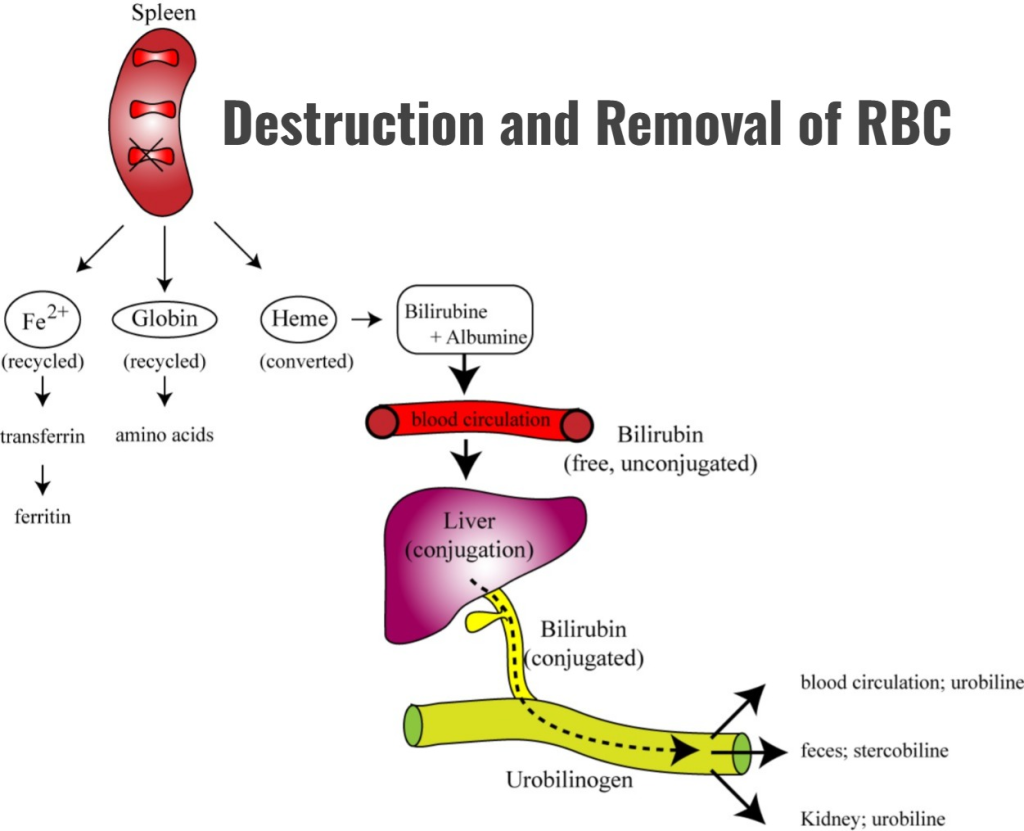
- The process of destruction of RBCs is called Hemolysis. The life span of RBCs is 90 to 120 days. The production and destruction of RBCs are maintained at the same rate.
- As the RBC approaches the end of its life span, its wall becomes weak and the process of degradation begins.
- In which the wall of the RBC breaks down and the broken parts of the RBC are distributed throughout the body through the liver, spleen and various reticuloendothelial systems.
- In which some cellular parts are cleared by the action of phagocytosis.
- Globin, heme portion and iron are released from the RBC wall.
- In which new protein synthesis occurs from the globin portion. Iron is converted into the form of ferritin and is reused during the synthesis of new R. B. C.
- Bilirubin and biliverdin are formed from the heme portion of RBC. Which is processed by the liver and exits the body through urine and stool.
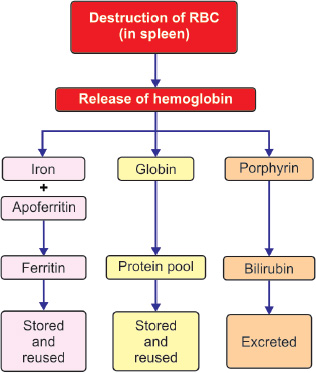
Hemoglobin (Hemoglobin):

- Hemoglobin is a complex protein associated with RBCs. Which R. B. C. It is located in the wall of the cell, which is known as the stroma. The wall of RBC is made of phospholipids.
- In hemoglobin, heme i.e. iron portion and globin i.e. protein portion combine and form hemoglobin.
- This hemoglobin contains 5% heme and 95% globin portion.
- The hemoglobin present in RBC combines with oxygen atoms from the lungs to form oxy-hemoglobin and oxygen is supplied to every cell tissue of the body through RBC.
- The bright red color of the blood is seen due to this oxygenated hemoglobin.
- The normal amount of hemoglobin in a person’s body is found to be 12 to 16 grams in females and 14 to 18 grams/dl in males.
- An increase in the number of RBCs in the blood than normal is known as erythrocytosis and a decrease in the number of RBC cells in the blood than normal is known as erythrocytopenia.
- A decrease in the number of RBCs in the blood than normal is known as The condition is also known as anemia.
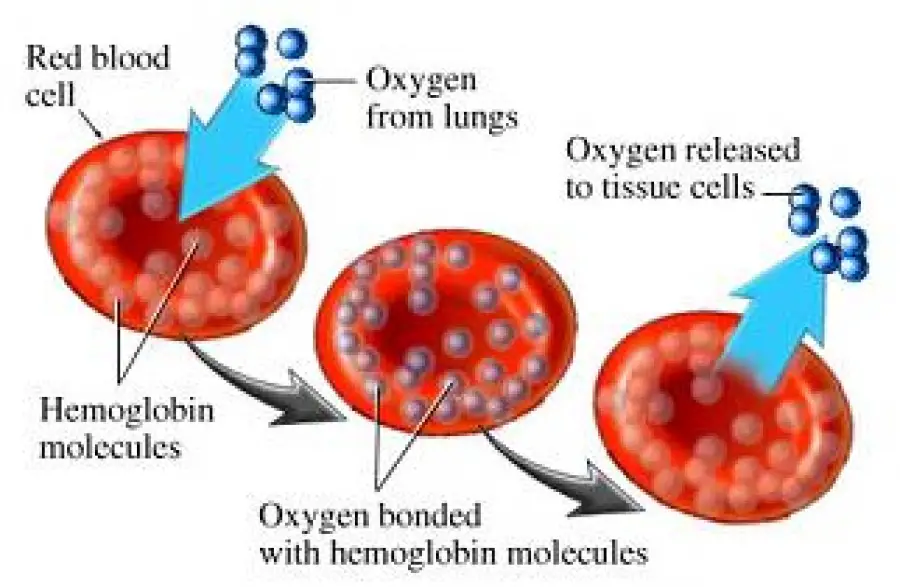
Functions of RBC:
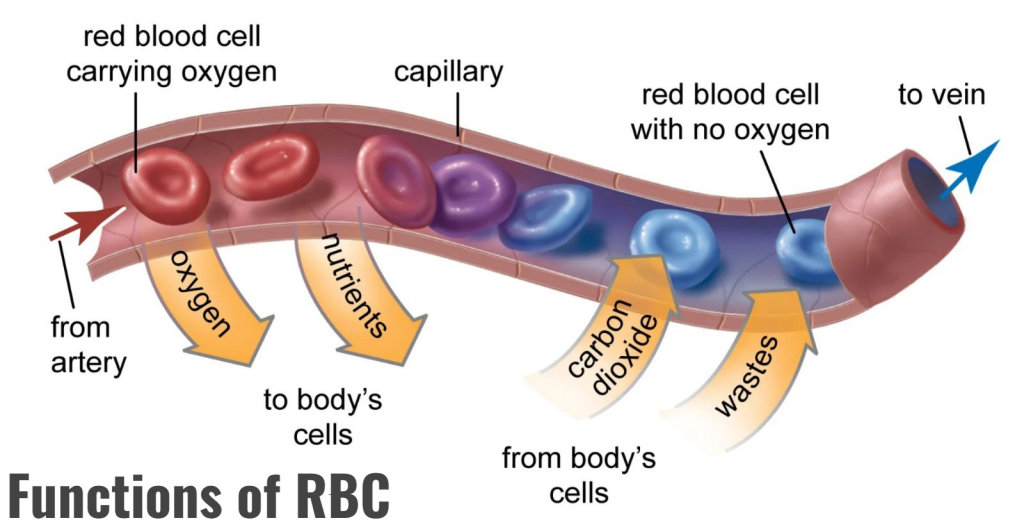
- RBCs transfer oxygen from the lungs to the body and its every cell and tissue.
- The hemoglobin in RBCs carries the waste product carbon dioxide to the lungs and helps in its removal from the body through exhalation.
- By removing carbon dioxide from the blood, RBCs also work to maintain the acid-base balance in the blood.
- Oxygen with hemoglobin Due to the binding of oxyhemoglobin Helps give blood a bright red color.
WBC (White Blood Cell : White Blood Cell):

- It is the largest cell in the blood. Its main function is to provide protection to the body and destroy microorganisms.
- One percent of all blood consists of W. B. C. cells.
- White blood cells are also known by the name of Leukocytes. Their number in the blood is 4,000 to 11,000.
- An increase in the number of white blood cells than normal is called leukocytosis and a decrease in their number than normal is known as leukocytopenia.
- These cells have a nucleus and also have the property of moving themselves so that they can easily reach the site of infection. Based on the distribution of granules in the plasma of wbc, they are divided into two types. 1. Granulocyte (Granulocytes) 2. Agranulocyte (Agranulocytes)
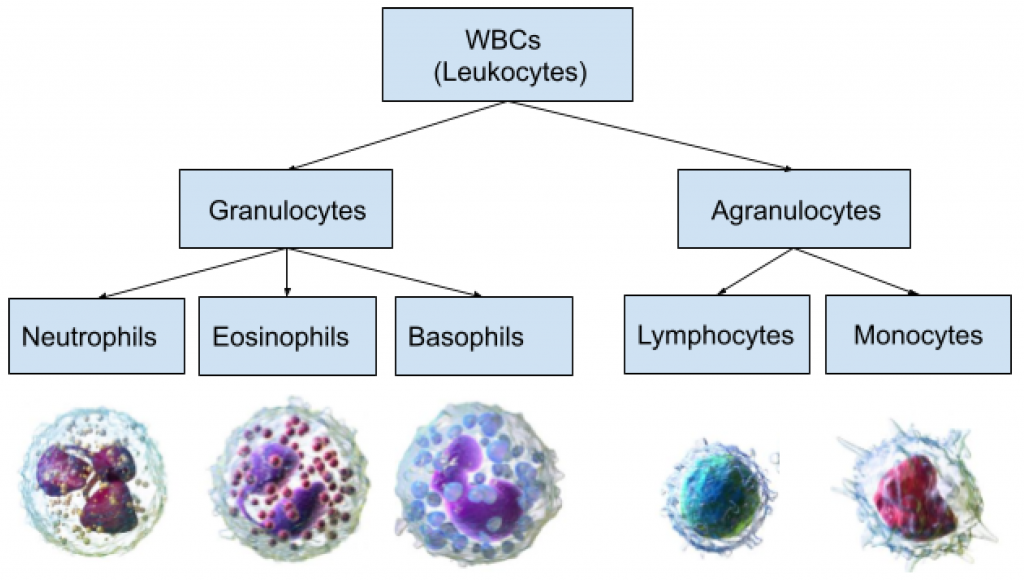
1. Granulocytes:

White blood cells contain a large number of granulocyte cells. These cells have a structure like granules in their cytoplasm. They also have a multi-lobed nucleus. Granulocyte white blood cells are further divided into three types.

A. Neutrophils:
- They constitute 60 to 70% of the total white blood cells.
- They function as phagocytic cells. Which has the property of engulfing microorganisms and destroying their cytoplasm.
- The nucleus in the cytoplasm of neutrophils has 2 to 6 lobes.
- These neutrophils work to protect the body against foreign material or microorganisms.
- They also work to remove waste material accumulated in the body.
B. Basophils:
- These cells constitute 0.5 to 1% of the total WBC. Their nucleus is bilobed and irregular in shape. These cells contain heparin, which acts as an anticoagulant.
- Basophils provide immunity to prevent parasitic infections.
C. Eosinophils:
- These cells are found in 2 to 4% of the total wbc. They have a two-lobed nucleus of B type in their cytoplasm. These cells have phagocytic properties. Their number increases during allergic reactions. These cells contain a protein called plasminogen. This protein helps in breaking down fibrin in blood clots.
2. Agranulocytes:

These cells have some non-specific lysosome-type granules in their cytoplasm. They constitute about 20 to 30% of the total white blood cells. This cell is divided into two main parts.
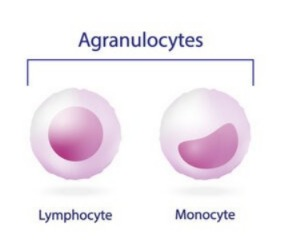
A. Monocytes:
- They constitute 3 to 8% of the total white blood cells. They are the largest of all WBC cells.
- These cells have a nucleus in the plasma. They have the property of being able to move and perform phagocytic functions.
B. Lymphocytes:
- They constitute 20 to 25% of the total white blood cells. They are found in small size. They have a nucleus. They are of two main types.
1. B Lymphocytes:
These cells are produced from the bone marrow. Which are important in producing antibodies against specific antigens.
2. T Lymphocytes:
Lymphocytes produced from the bone marrow are processed in the thymus gland and converted into T lymphocytes. These cells are very important in maintaining cellular immunity.
White blood cells are produced in the bone marrow. This process of production is known as leukopoiesis.
The process of producing white blood cells also occurs in lymphoid tissue, spleen, and tonsils.
Functions of White Blood Cell:
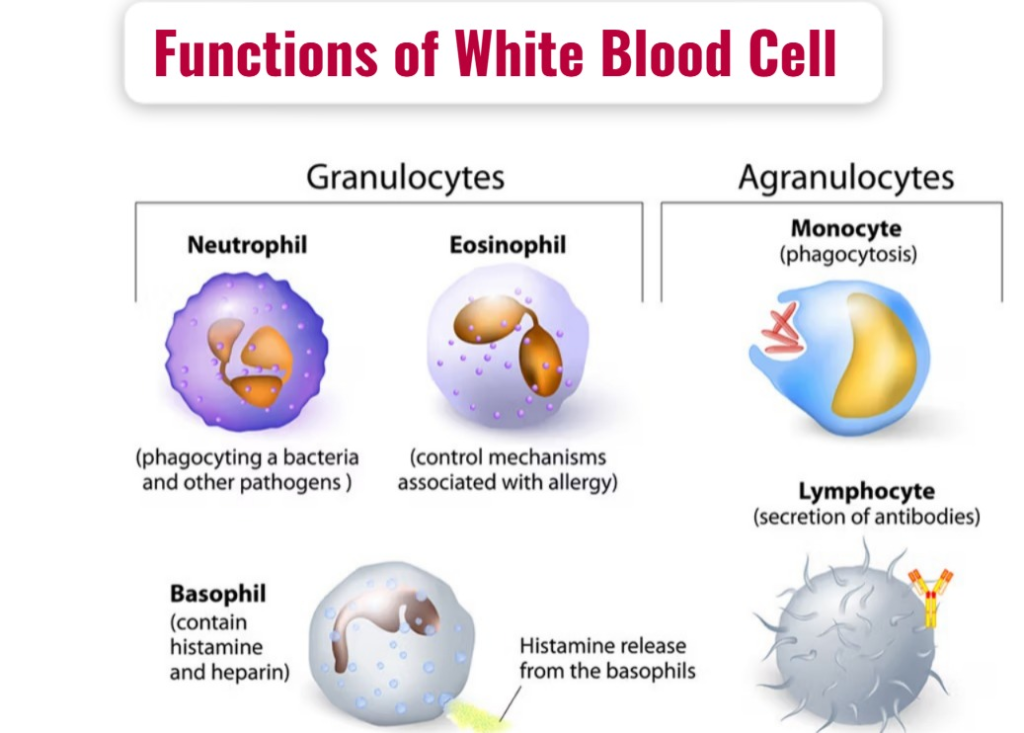
The main function of WBC is phagocytosis.
Phagocytosis:
- The white blood cells in our body engulf microorganisms or foreign material in their cytoplasm and destroy them with their chemicals. This action is called phagocytosis.
- It also works to repair some tissues in the body.
- This cell works to maintain immunity in the body.
- Since heparin is released by this cell, it also acts as an anticoagulant.
Platelets (Platelets):
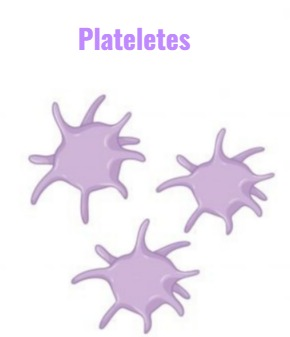
- These cells are also known by other names, such as thrombocytes. These cells are small in size and do not have a nucleus.
- The cytoplasm of these cells contains granules.
- The normal platelet count is 150,000 to 450,000 per microliter (µL) of blood.
- The main function of these cells is to clot blood. With its help, the process of blood clotting occurs.
- A higher than normal amount of this cell in the body is called thrombocytosis and a lower than normal amount of the cell is called thrombocytopenia.
- After this cell reaches the bloodstream, it stores a chemical and that chemical is also very important for repairing the damaged inner lining of the blood vessels.
- The life span of a platelet cell is 7 to 10 days.
Hematopoiesis:

- The process of producing blood cells from bone marrow is called hematopoiesis.
- Bone marrow is found in the red bone marrow of long bones and flat bones. Which is the primary site for the production of these blood cells.
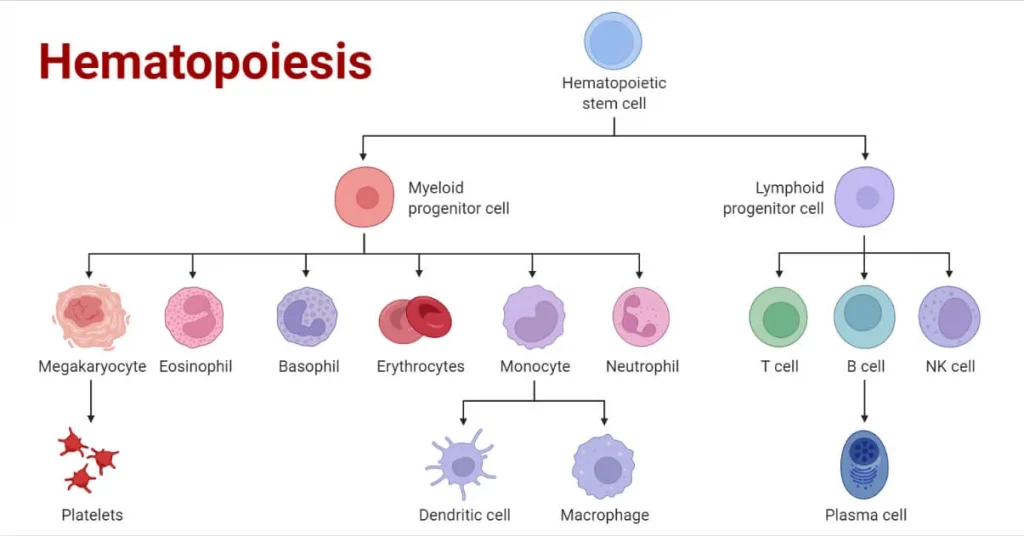
Functions of blood (ब्ल्डना Functions):
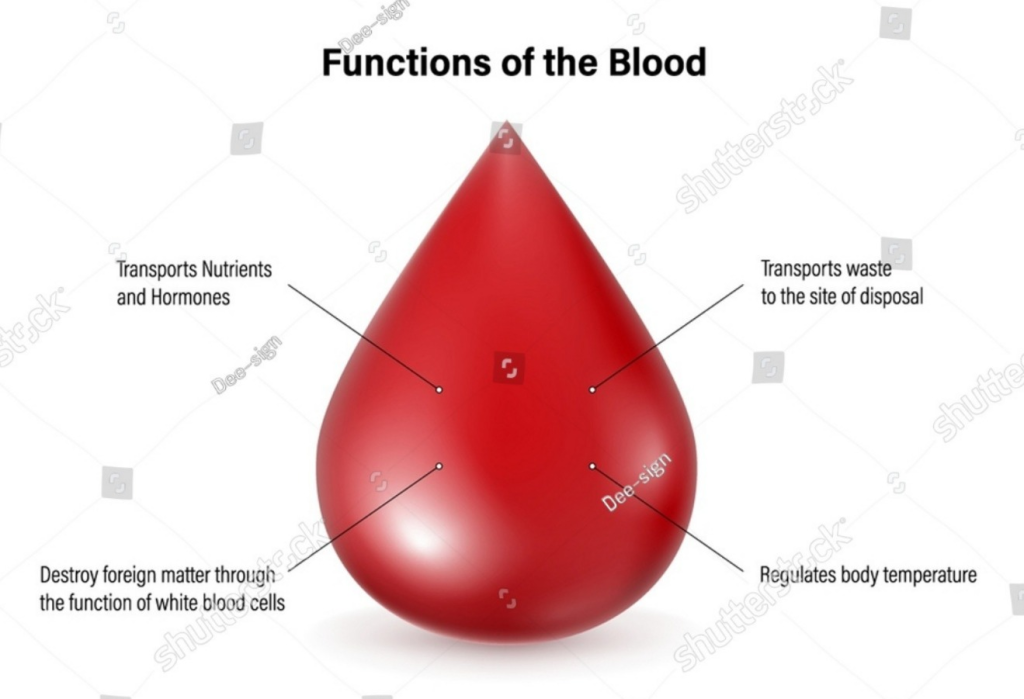
Blood is a major liquid in the body. Which performs the following functions.
1. Blood performs mainly transportation-related functions, which include the following activities.
- Blood transfers oxygen from the lungs to body tissues and carbon dioxide from body tissues to the lungs.
- Blood transports nutrients absorbed from the alimentary canal throughout the body.
- Blood carries hormones from the endocrine glands to their target cells.
- Transports waste products produced at the end of metabolism to the excretory organs of the body. is.
- Helps in transporting the hit generated in the body to the entire body.
2. Blood functions to regulate certain functions in the body, which are as follows.
- Blood maintains the pH of acids and bases in the body and blood acts as a buffer solution.
- Blood maintains the amount of water and electrolytes in the body.
- Blood regulates body temperature.
3. Blood also performs some protective functions, which are as follows.
- The white blood cells in the blood protect the body by protecting it against microorganisms due to their specific characteristics.
- They protect the body from certain toxic substances.
- The blood clotting mechanism prevents excessive blood loss from the body due to the clotting property of blood cells.
Hemostasis:
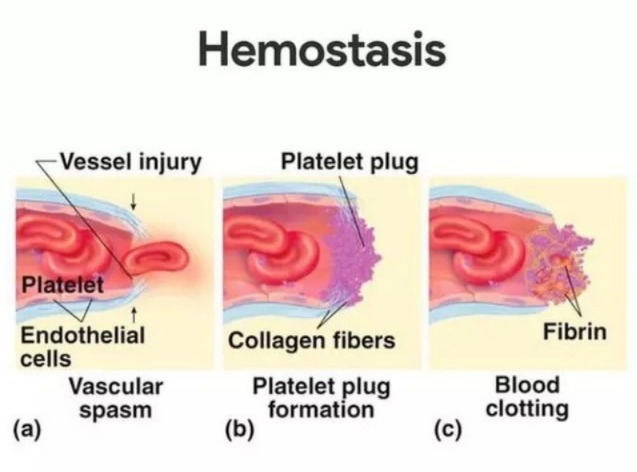
Hemostasis is the process of stopping blood flow. When bleeding occurs due to injury anywhere in the body, if there is no blood clotting mechanism, then the blood of the entire body flows. But this does not happen. The blood flow is stopped by the process of hemostasis in the body. Three phases are seen in this process. which are as follows.
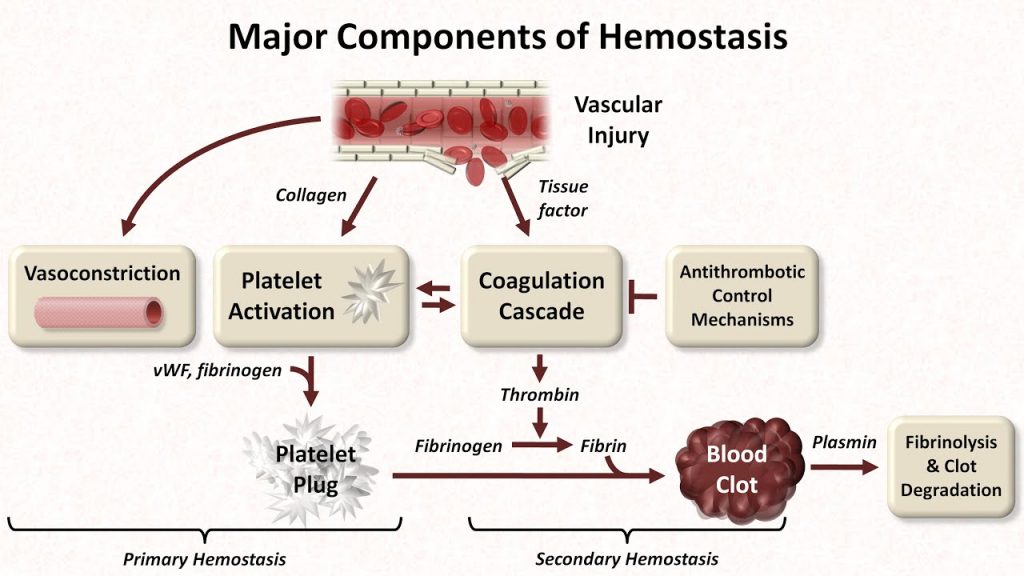
1. Vasoconstrictive Phase:

In this phase, when blood flows out of damaged blood vessels, chemicals are released around them and the injured smooth muscles spasm. is.
The spasm of muscles and the release of vasoconstrictive chemicals cause the blood vessels to constrict and reduce blood flow to the injured area. This phase is called the vasoconstrictive phase. During this phase, blood clotting is promoted by reducing blood flow to the injured area.
2. Platelet Plug Formation:

When blood flows through injured blood vessels, platelets are released. This releases a chemical called adenosine diphosphate from the injured area, which attracts more platelets to it, and the platelets stick to the damaged blood vessels and form a temporary seal. This seal causes a reduction in blood flow.
3. Blood Coagulation or Blood Clotting Mechanism:
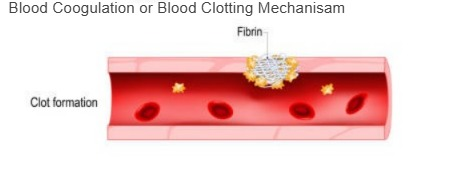
In this mechanism, many chemical reactions are seen in a series. In which a chemical called thromboplastin is released from the site of damaged blood vessels. This released thromboplastin combines with calcium ions to convert prothrombin into thrombin.
This thrombin converts fibrinogen into fibrin and fibrin forms a network of fibers around the injured area. Blood cells become trapped in this network and a blood clot is formed.
Thrombin activates a fibrin stabilizing factor. Which gives additional strength to the fibrin strands so that this blood clot becomes hard and this mechanism continues until the blood flow from the injured area is completely stopped.
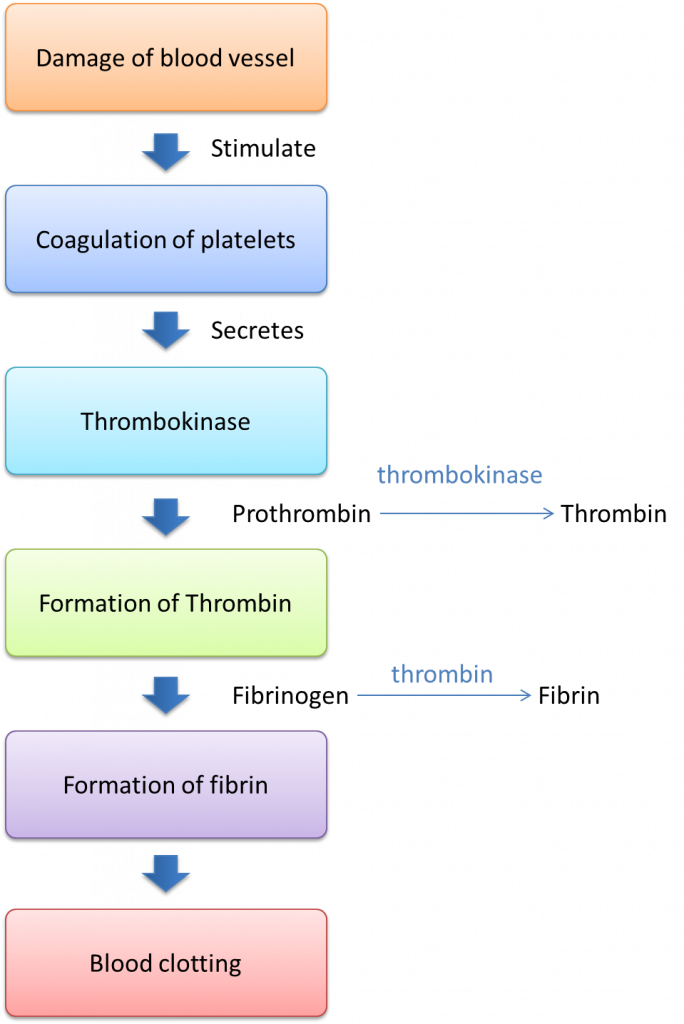
4. Fibrinolysis:

This is a physiological mechanism for the dissolution of blood clots. In which plasminogen is converted into plasmin and that plasmin acts to break the fibrinogen strands and through the action of phagocytosis, all the waste material of fibrin is absorbed from there.
The action of complete hemostasis is seen in the above four phases.
Blood group (blood groups):
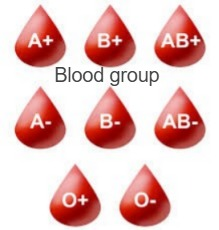
- Carl Landersen discovered blood groups and divided them into four main groups.
- Every person has one of these four blood groups.
- These blood groups include A, B, AB and O.
- These blood groups are named after the antigens on the walls of their RBCs.
- Blood Plasma contains antibodies other than that blood group. If any other antigen enters the body, antibody antigen reaction occurs and RBC is destroyed. This process is called hemolysis.
- If the donor’s blood does not match the recipient’s blood, it is called incompatibility.
- For example, type A blood has A antigens on the wall of its RBC and B antibodies. This is how antigens and antibodies are arranged in the blood.
- AB blood group has both A and B antigens. It does not contain any antibodies. Therefore, AB group is known as the universal recipient.
- Blood group A does not have any antigens, A or B, it has both types of antibodies. This group is known as the universal donor.
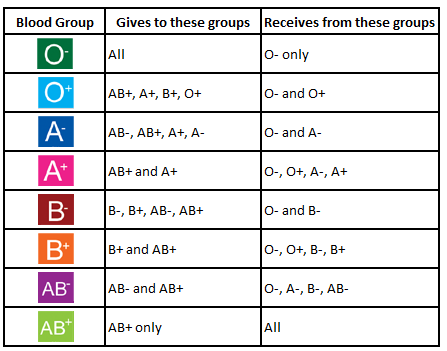
Rh system… Rhesus system…(Rh system… Rhesus system.)
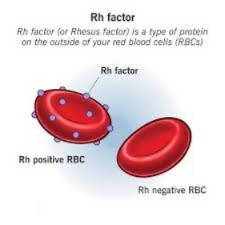
- Rh means Rhesus. If this type of protein is present on the wall of RBC, then the person is called Rh positive and if this type of protein is not present on the wall of RBC, then the person is called Rh negative.
- An estimated 80% of people are found to be Rh positive and 20% of people are found to be Rh negative.
- If Rh positive blood is given to an Rh negative person, an immune response is created in him and the blood cells are destroyed, i.e., hemolysis occurs. It is also called a transfusion reaction.
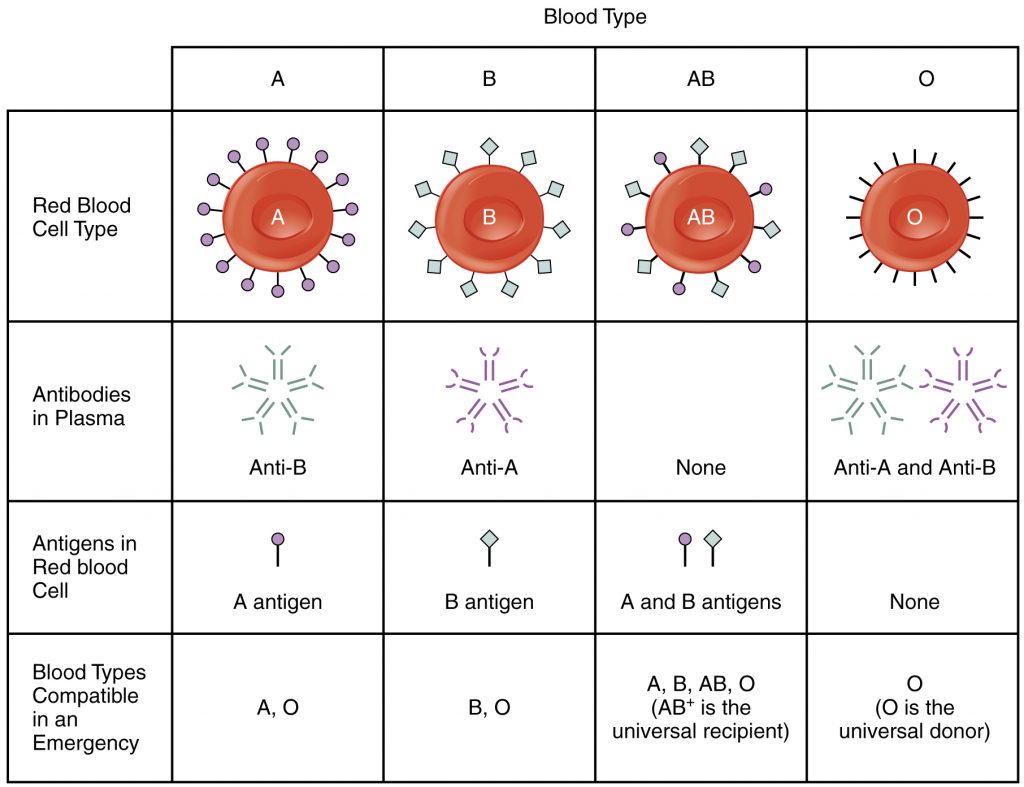
Write the difference between R.B.C. and W.B.C.
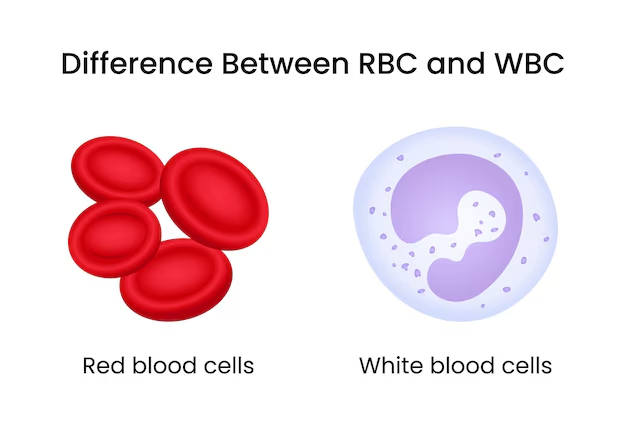
(Write the difference as a question. Here for the sake of simplicity, both are given.)
- R. B. C. appears red in color while W. B. C. is white in color or colorless.
- R. B. C. is circular biconcave disk-shaped while W. B. C. is round in shape.
- R. B. C. The nucleus is absent in RBC while the nucleus is present in WBC.
- R. B. C. is involved in the transportation of oxygen while W. B. C. is involved in maintaining immunity and defense mechanism in the body.
- R. B. C. has a life span of 90 to 120 days while W. B. C. The life span of a red blood cell is 5 to 21 days.
- Its function is related to the cardiovascular system while the function of WBC is related to both the cardiovascular system and the lymphatic system.
- R. B. C. constitutes 40 to 45% of the total blood while WBC constitutes 1% of the total blood.
- R. B. C. Only one type is found in the blood, while five types of WBC are found in the blood.
- RBC has the property of circulating only in the blood circulation, while WBC can also travel in the connective tissue and lymphatic system when needed, in addition to the blood circulation.
- RBC. Anemia is seen due to a decrease in the number of RBCs compared to normal, while WBC. C. Leukopenia is seen due to a decrease in the normal number.
Blood Product and Their use:
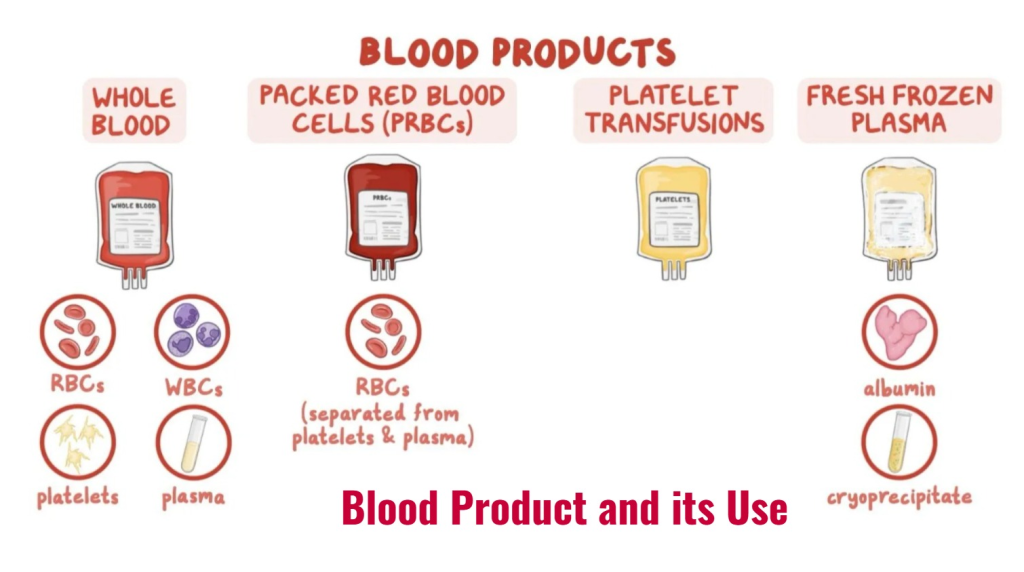
1.Red Cell Concentrate:
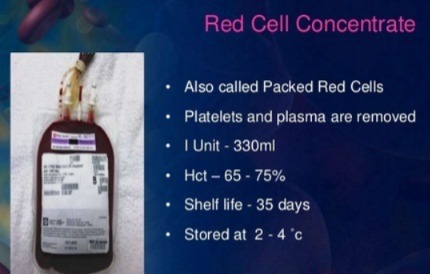
Red Cell Concentrate (Red Cell Concentrate) i.e. Packed Red Blood Cells (PRBCs) is a blood product that has a high hemoglobin content and a low amount of plasma.
Uses:
- In conditions like Anemia
- Blood Loss – Trauma (Trauma), Surgery
- Chronic blood disorders like Thalassemia
2. Platelet Concentrate:
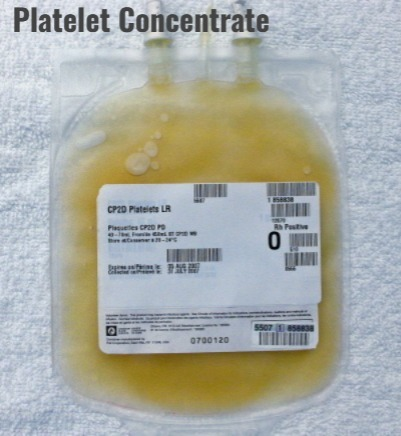
Platelet Concentrate is platelets separated from blood, which are mainly useful for bleeding control.
Use:
- Thrombocytopenia
- In severe cases of dengue fever (Dengue Fever with low platelets)
- Bone Marrow Disease
- Due to decreased platelet levels after chemotherapy
3.Fresh Frozen Plasma (FFP):
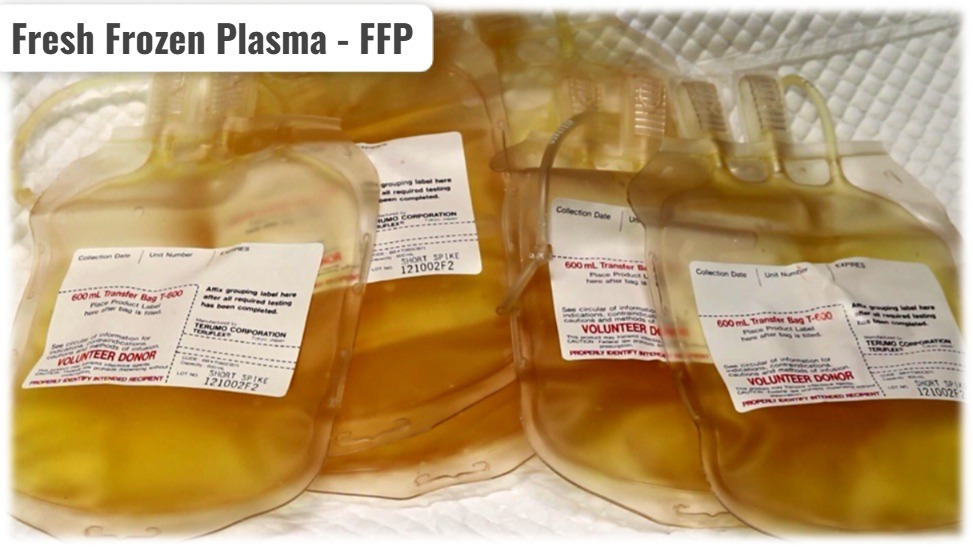
Fresh Frozen Plasma (FFP) is a fraction of plasma that contains various types of clotting factors. is.
Use:
- Clotting Disorders
- Liver Failure
- D.I.C. (Disseminated Intravascular Coagulation – DIC)
- Plasma Exchange Therapy
4.Cryoprecipitate:
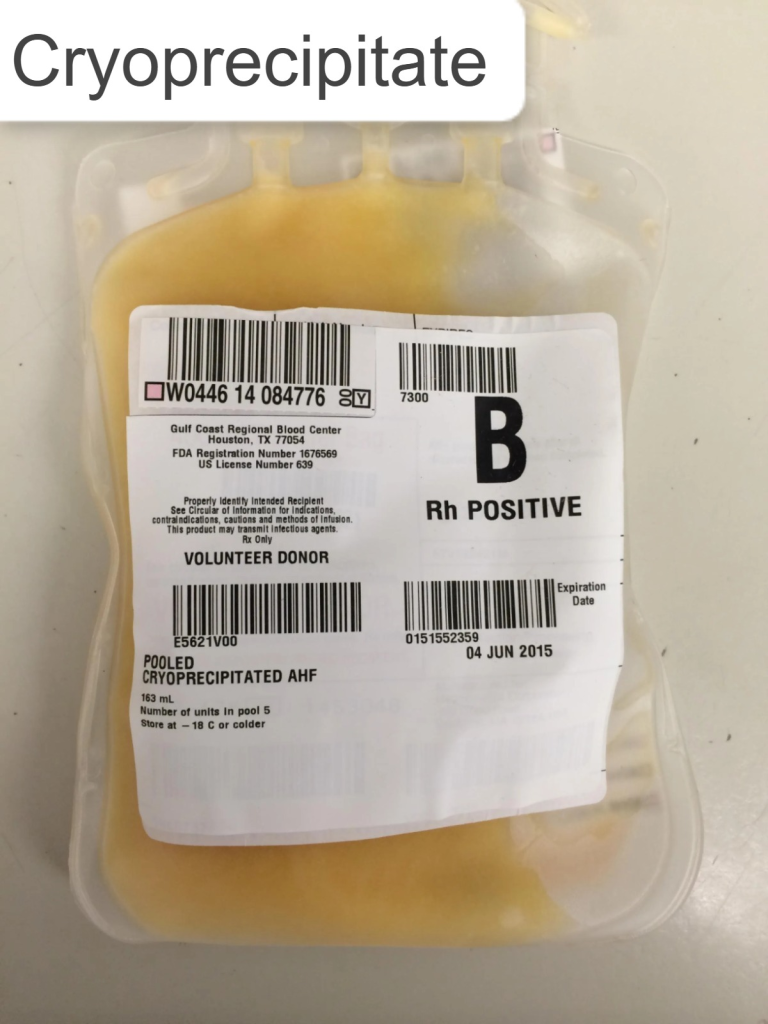
Cryoprecipitate is a protein-rich plasma component prepared from plasma and contains fibrinogen, factor VIII, and von Willebrand Factor.
Use:
- Hemophilia A
- Hypofibrinogenemia
- Von Willebrand Disease
5.Whole Blood:
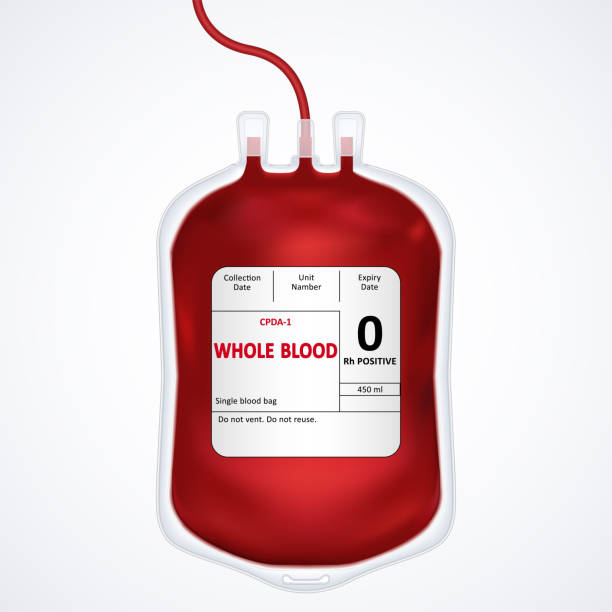
Whole blood is complete blood in which all components such as red cells, white cells, platelets and plasma are present. Nowadays, with the development of component therapy, the use of whole blood is limited.
Use:
- Massive Blood Loss
- In emergency conditions such as trauma or shock
- Remote Areas where blood components are not available Not available
6.Albumin:
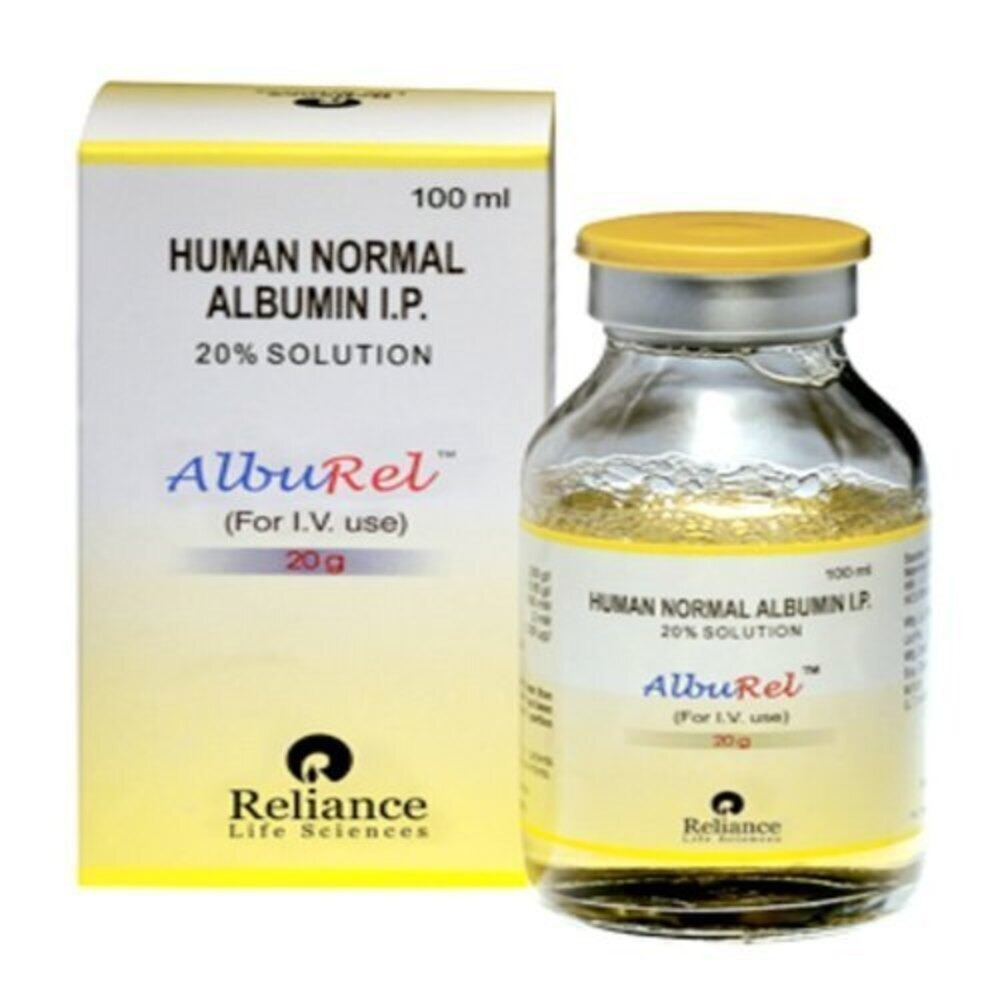
Albumin is the main protein in plasma that maintains oncotic pressure and helps bind drugs.
Uses:
- Hypoproteinemia
- Burn Injuries
- Liver Cirrhosis
- Hepatic Encephalopathy
7.Immunoglobulin:
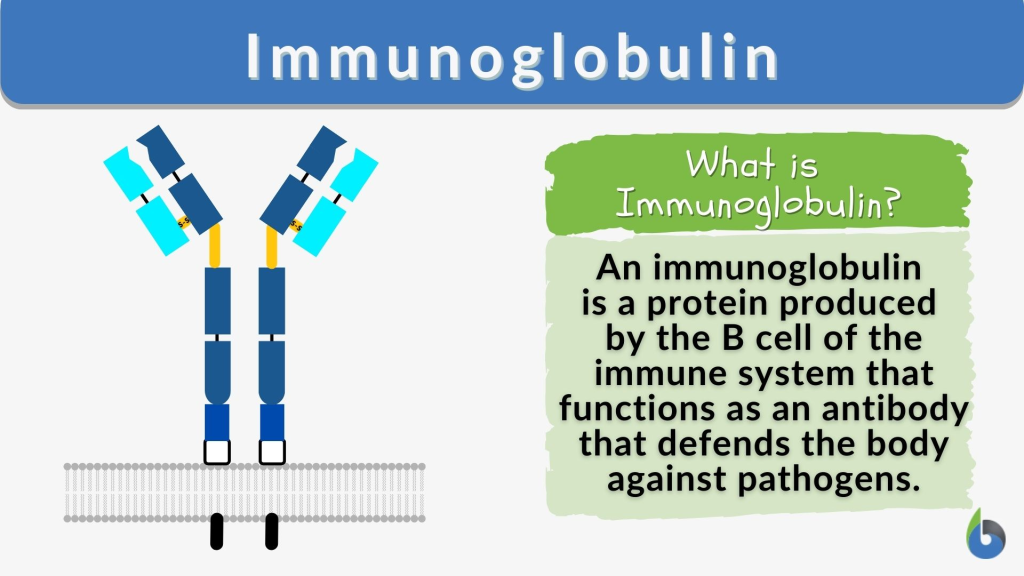
Immunoglobulin is a special type of antibody-filled blood product, which is useful in immune system related diseases.
Use:
- Primary Immunodeficiency
- Guillain-Barré Syndrome
- Idiopathic Thrombocytopenic Purpura (ITP)
